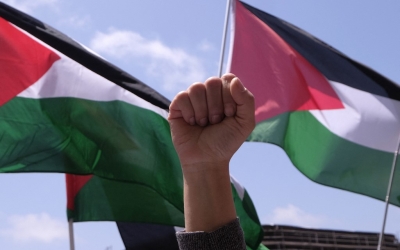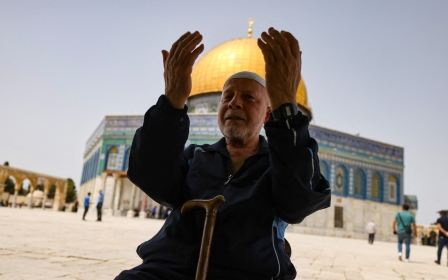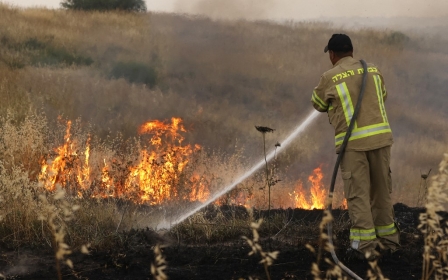Israel's war on Gaza: One year on, Palestinian resistance prevails

A year ago, after repeated Israeli incursions into al-Aqsa Mosque complex and settler attacks on Palestinian families in Jerusalem’s Sheikh Jarrah neighbourhood, Hamas launched a military response, firing a barrage of rockets at Israeli targets. The Palestinian Authority (PA), for its part, was criticised for inaction in the face of Israel’s assaults.
The 11-day Gaza war was added to three previous wars in recent years, in 2008-09, 2012 and 2014. Around 250 Palestinians, including dozens of women and children, were killed in the 2021 conflict.
The unintended consequence for Israel has been the wider growth of Gaza's message of resistance
One year on, the curve of gains and losses in the Palestinian political scene has shown gradual advances for Hamas and further erosion of the PA’s political legitimacy, alongside worsening conditions for average citizens in Gaza. At the same time, Israel has deepened its military control over the whole country, amid the ongoing expansion of illegal settlements.
Against this backdrop, we have seen the emergence of a broader Palestinian resistance to Israel’s apartheid system on both sides of the Green Line. The widespread protests that gripped the country ahead of last year’s war have since continued on a sporadic basis, and today, a sense of united resistance prevails across historic Palestine.
Whether this marks a new chapter in the conflict, guided by the theme of “one land, one resistance” in response to Israel’s relentless colonisation, remains to be seen.
Apartheid policies
The notion of “one land, one resistance” must be seen in the context of Israel’s unified, all-encompassing, brutal system of occupation, siege and apartheid against Palestinians in Jerusalem, the West Bank, Gaza and 1948 territories. The extent of Israel’s racist policies has been catalogued in detail by major international rights watchdogs, including Amnesty International, Human Rights Watch and the United Nations.
In parallel with the accumulation of such policies has been an impasse over a political solution, deepening the collective Palestinian sense of frustration. Indeed, the continuous rise of Israeli religious and ethnic extremism, from the government to settlers, provides the guiding context for everything that is taking place in the country.
During the past year, manifestations of resistance have grown across the occupied West Bank, particularly in cities such as Nablus and Jenin. Desperate attacks by individual Palestinians have moved further into Tel Aviv and the Naqab (Negev), in tandem with harsher Israeli policies against Palestinians inside Israel.
The holy month of Ramadan was also marked by an intensification of violence in Jerusalem, and Israel sealed off crossings with the occupied West Bank and Gaza during Passover.
Palestinians have been left with no option besides further resistance, hoping that a world preoccupied with the Russia-Ukraine war and other crises will finally listen to their suffering and act accordingly. Their alienated leadership within the PA is crippled politically, and functionally boxed in by a system of security coordination with Israel, whose maintenance has become vital to the very existence of this leadership.
National leadership
Moves to prolong the proxy-esque Palestinian leadership after President Mahmoud Abbas, 87, is out of the picture have continued over the past year. In recent months, Abbas ensured that the Palestine Liberation Organization was stacked with senior officials loyal to his agenda. In a development that appeased Israel and the US while infuriating many Palestinians, Hussein al-Sheikh, a close ally of Abbas with strong ties to Israel, emerged as his likely successor.
Hamas, meanwhile, is not in a practical position to assume the role of national leadership. Internally, there is no clear path for Hamas or any other party to legally compete for the Palestinian leadership, particularly after elections were indefinitely postponed last year.
The main external players - including the Israeli government, the US, Egypt and Jordan - are all angling to preserve the current servile Palestinian leadership. At the same time, under Hamas leadership, Gaza remains in crisis, with many homes still in ruins as poverty and unemployment soar. Families in Gaza routinely pay the price for the firing of Hamas rockets.
Yet, despite all odds, Hamas still appears to be gaining political clout. Recent negotiations involving Qatar and Egypt have taken place in Gaza, as the PA in Ramallah becomes increasingly irrelevant.
One of the main declared objectives of Israel’s frequent attacks on Gaza for more than a decade has been the notion of “mowing the grass”, which entails using massive force repeatedly to reduce the military capabilities of Palestinian armed groups. But the unintended consequence for Israel has been the wider growth of Gaza’s message of resistance, which today permeates the whole land from the river to the sea.
The views expressed in this article belong to the author and do not necessarily reflect the editorial policy of Middle East Eye.
Middle East Eye propose une couverture et une analyse indépendantes et incomparables du Moyen-Orient, de l’Afrique du Nord et d’autres régions du monde. Pour en savoir plus sur la reprise de ce contenu et les frais qui s’appliquent, veuillez remplir ce formulaire [en anglais]. Pour en savoir plus sur MEE, cliquez ici [en anglais].







